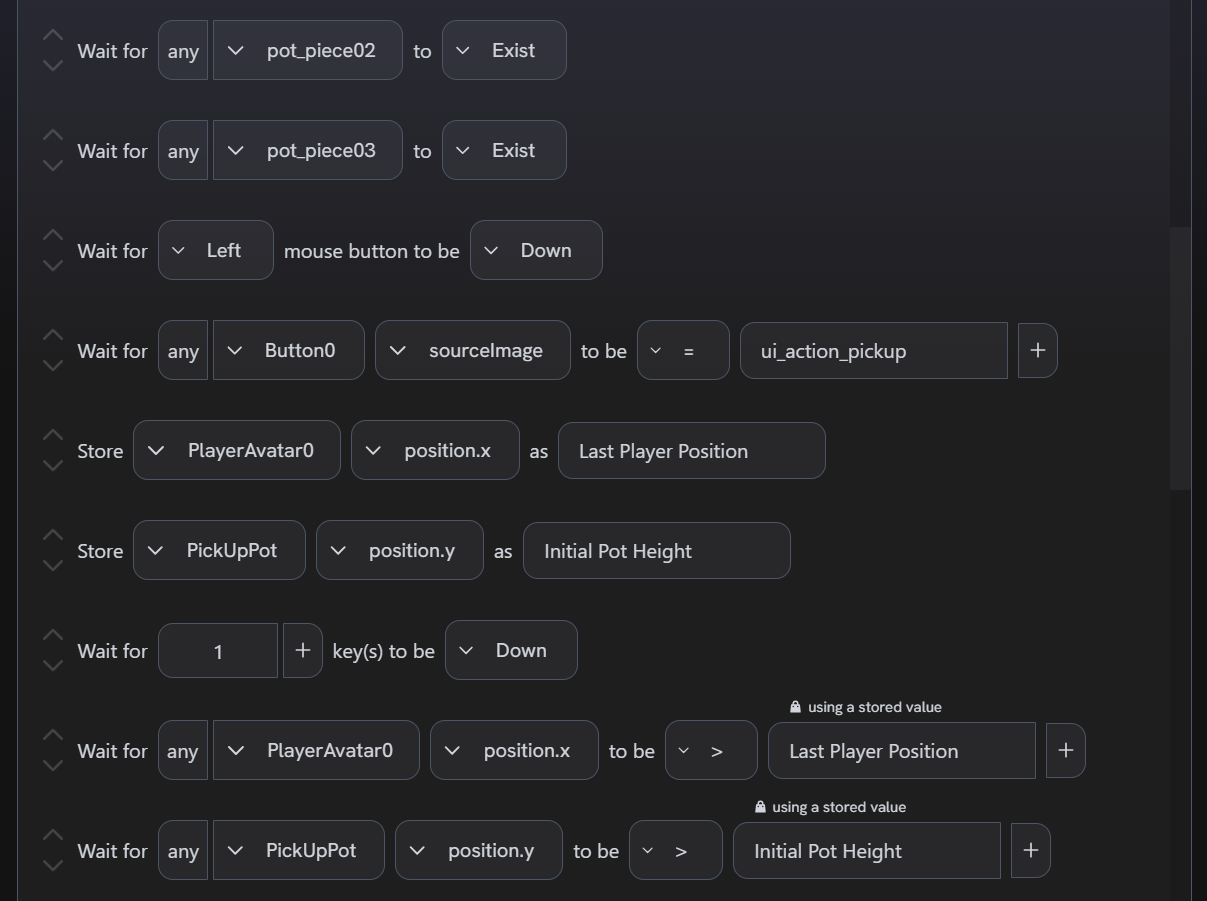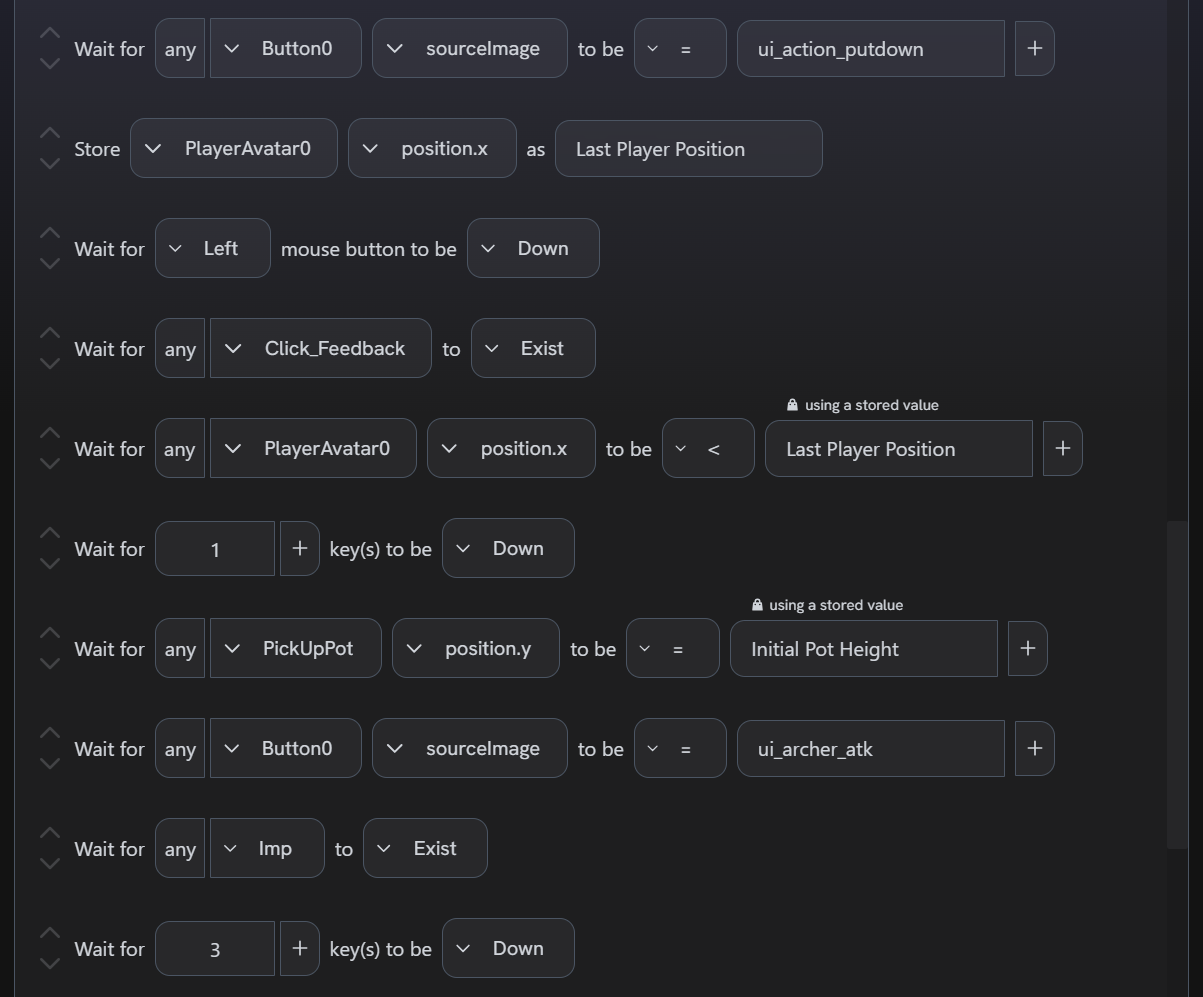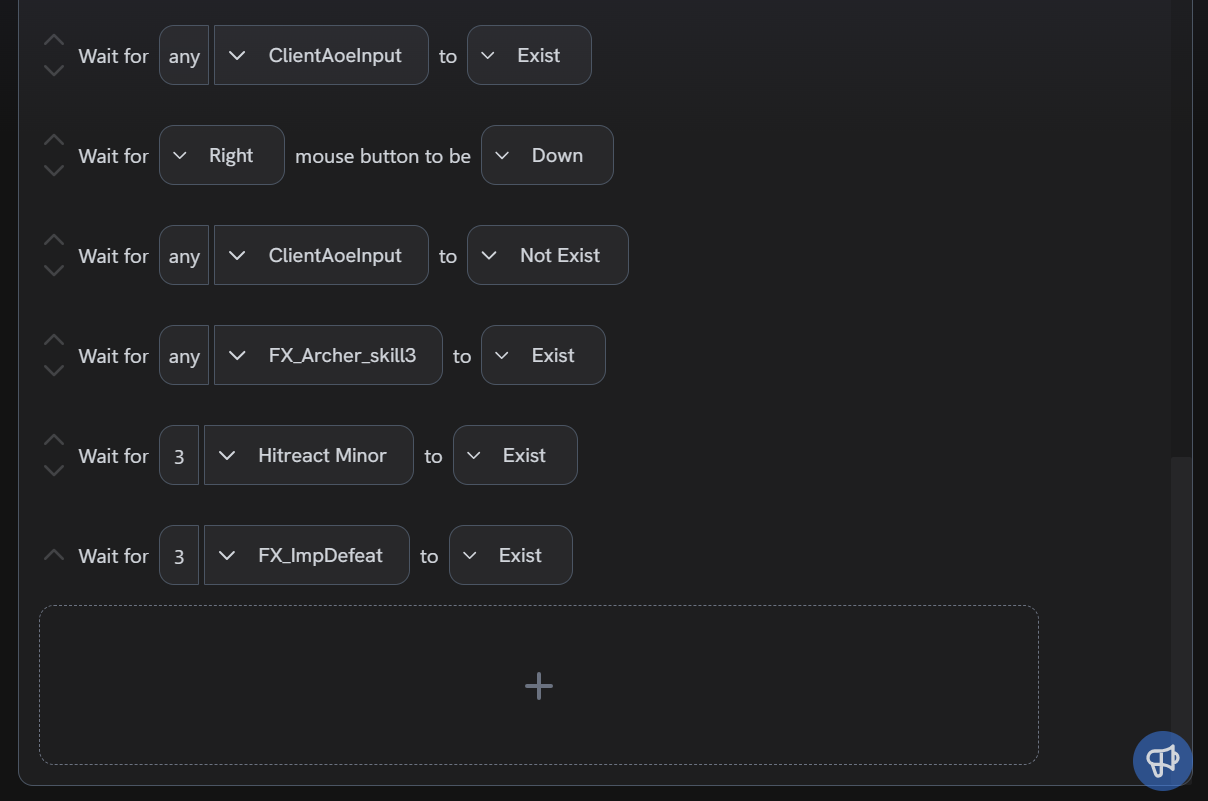Writing Advanced Validations
This guide provides in-depth examples for validating gameplay using Validation Suites.
✓ how to build validations for common scenarios such as navigating menus and exercising core gameplay mechanics
✓ how to establish potential cause-and-effect relationships between actions and changes in the game state
✓ how to build validations around non-deterministic behaviours
This guide uses gameplay from Unity's Boss Room sample project. You can follow along by downloading Boss Room and installing our core SDK, or you can apply the concepts covered throughout this guide to your own project. You can also try out our validations tools from our Website Demo, although the demo lacks some gameplay from this guide.
Each example describes how to recreate the gameplay it validates. If you're following along, see our Core Concepts section for instructions on capturing a Gameplay Session and creating a Validation Suite from that Session to start building Validation Scenarios.
Changing In-Game Settings
Let's start with a simple Validation Scenario.
For this Gameplay Session: we open the settings menu then increase the music volume and toggle graphics quality from "Medium" to "High".
In the Scenario Builder: we'll validate that the settings were changed successfully.
Set the recording interval to 1. This is necessary for capturing changes to the settings menu.
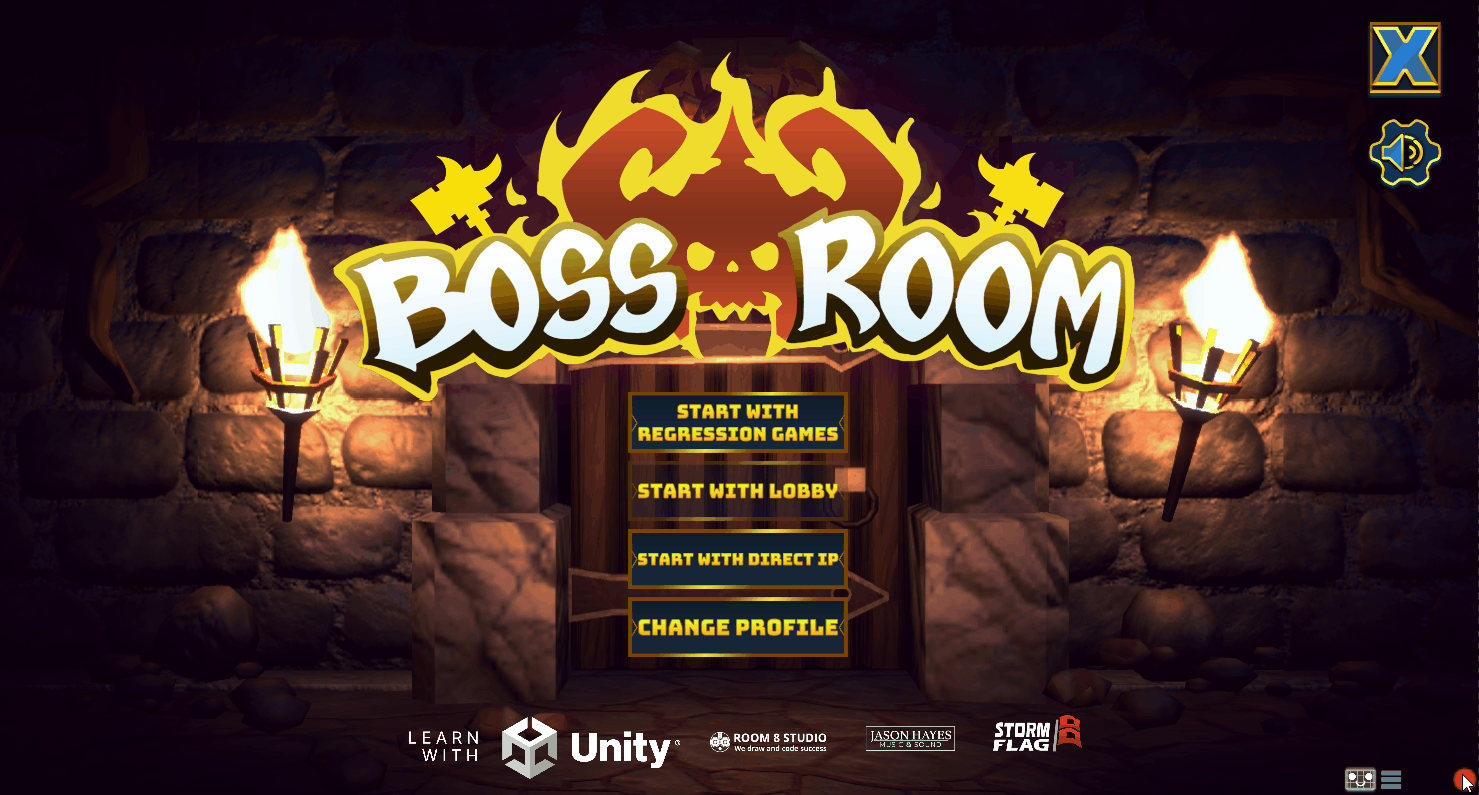
We'll start building the Scenario by waiting until the MainMenu scene is loaded.
Many games use startup scenes to initialize data, so it's good practice to make sure the Scenario is at the correct scene
before running other steps.
Then, we'll wait for the settings menu to be open.
We can do this by adding a "Wait for Existence" step and selecting SettingsPanel from the dropdown.
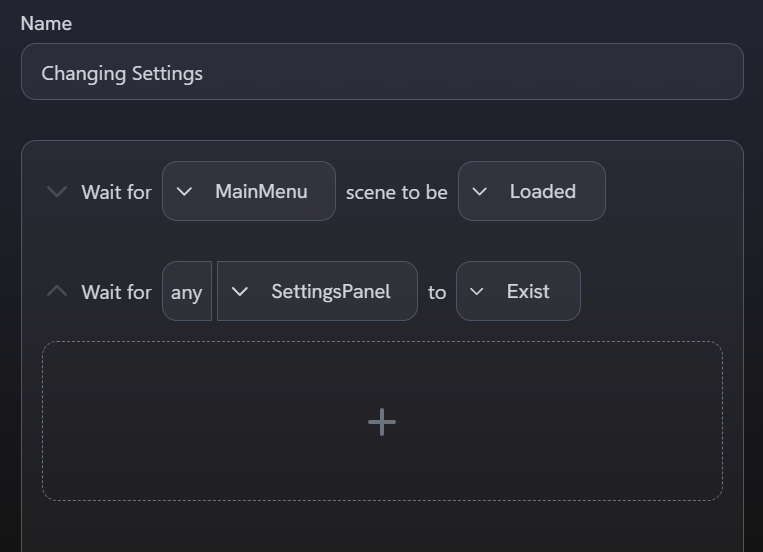
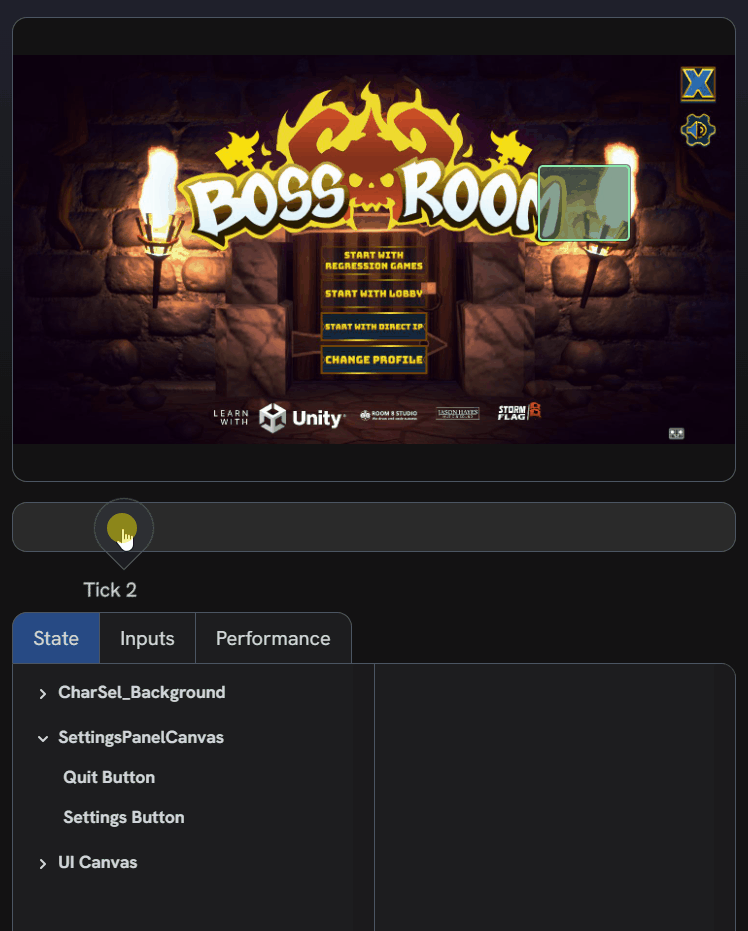
Waiting for the settings menu to exist in the game state is very important for the next step: capturing the initial music volume. We can use the "Store Value" step to save a value and reference it later in the same Scenario. "Store Value" always runs on the tick that the previous step left off - this means that if we attempt to capture the initial volume before the settings menu exists, then the step won't be able to find the slider and will fail.
The actual volume value that the slider's position should translate to isn't present in our collected game state data,
but we can check that the UI handle's position changes over time to validate that the user adjusted the slider.
Store the Handle's position.x value as "Volume Value".
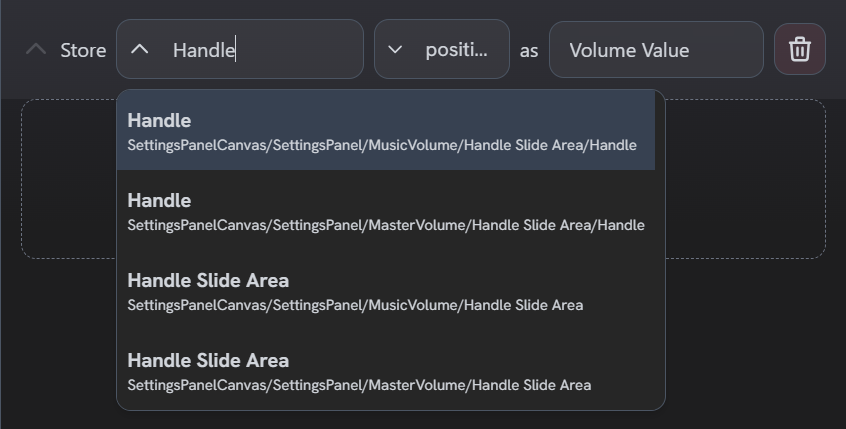
Handle entity for the correct volume slider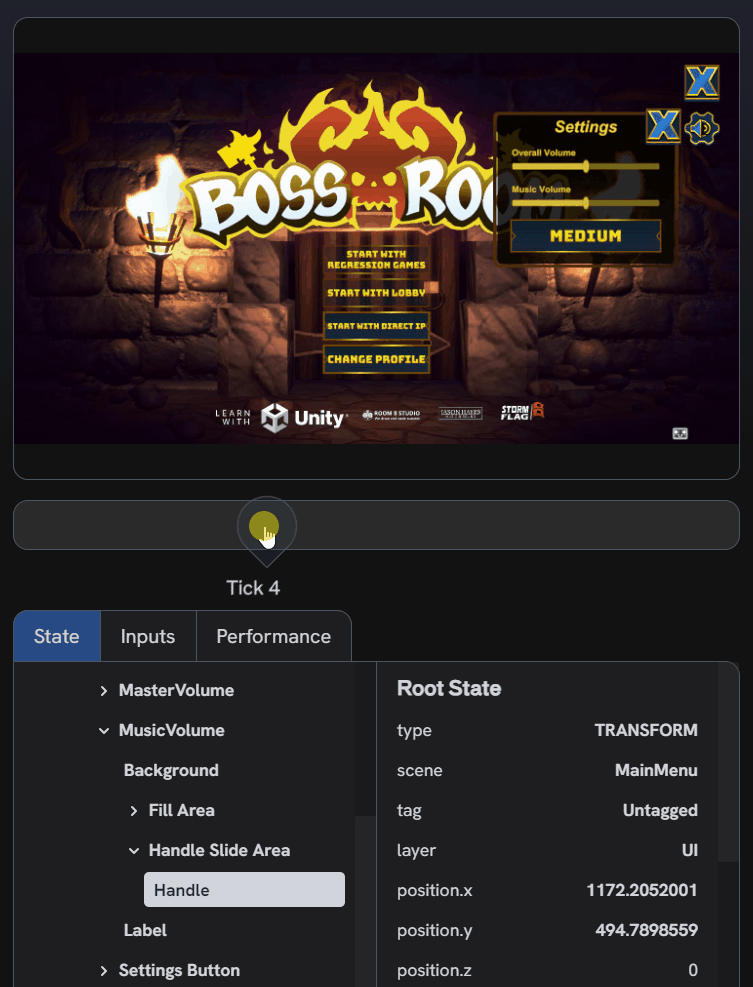
Now, we need to validate that the volume increases.
Add a "Wait for State" step and select the same Handle entity and its position.x field from the first two dropdowns.
Select "greater than" (>) as your comparator.
Clicking on the last field will reveal a dropdown with your available stored values.
Select "Volume Value".
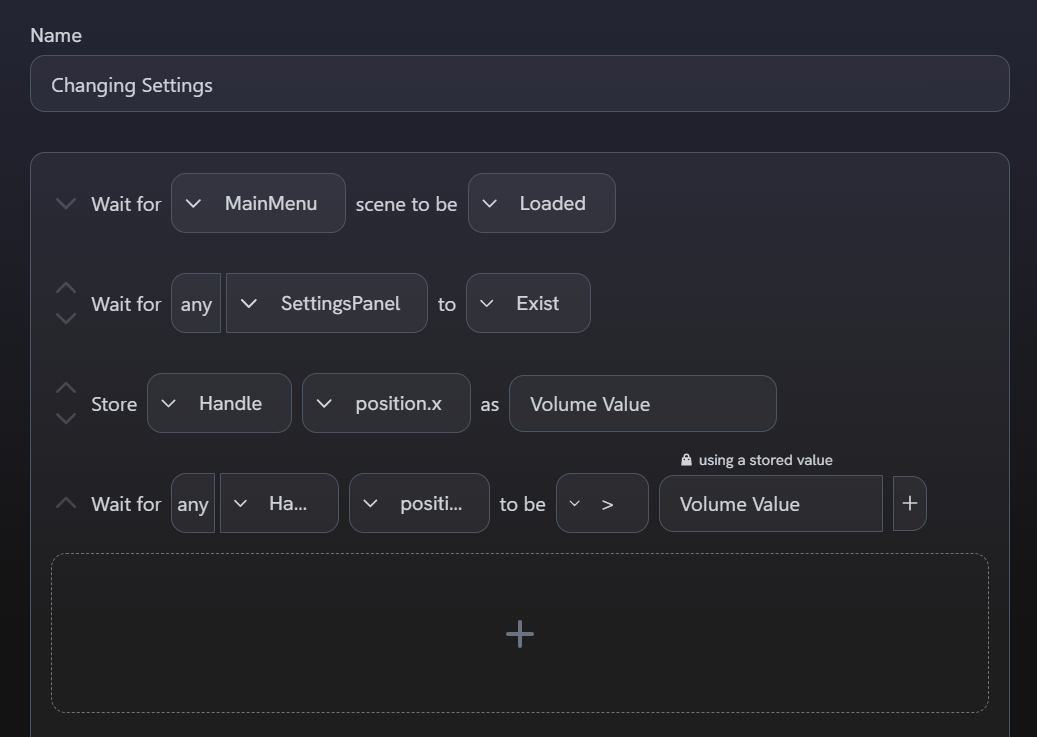
The last task in building our Scenario is validating that the user changed the graphics quality from "Medium" to "High".
Start by validating that the initial state is "Medium".
Add a "Wait for State" step and find the Text component that belongs to the Settings Button entity,
then select its text field. Type "Medium" into the comparison field.
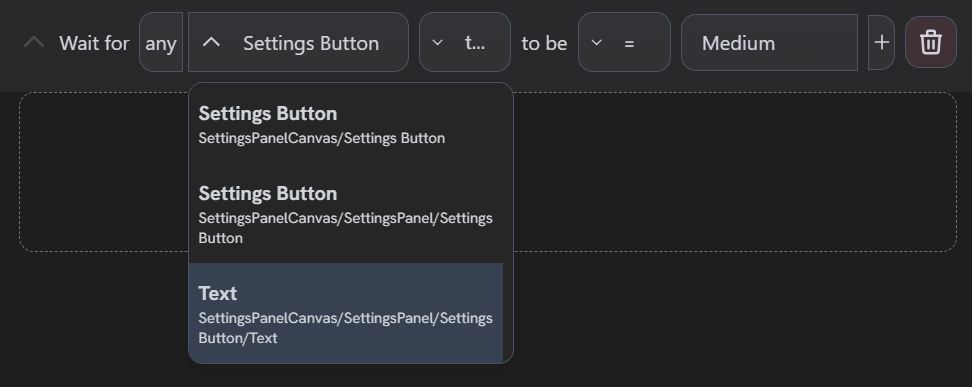
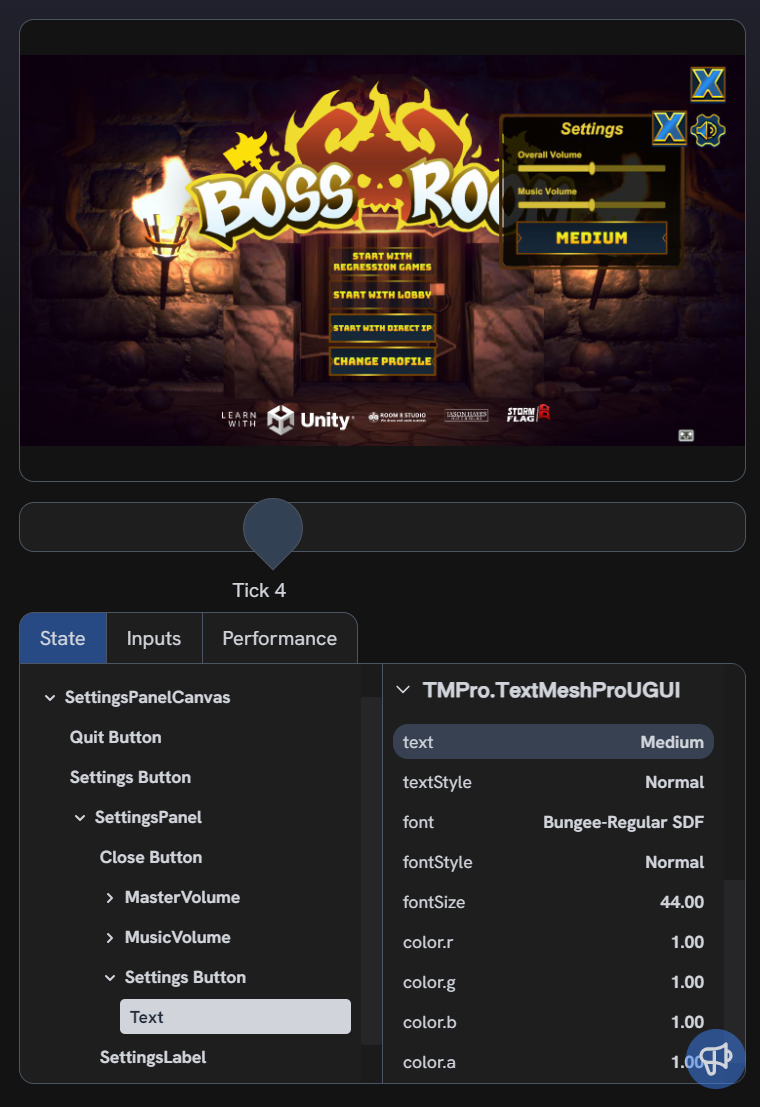
Finish the Scenario by repeating this process for the text "High" instead of "Medium".
Final Scenario
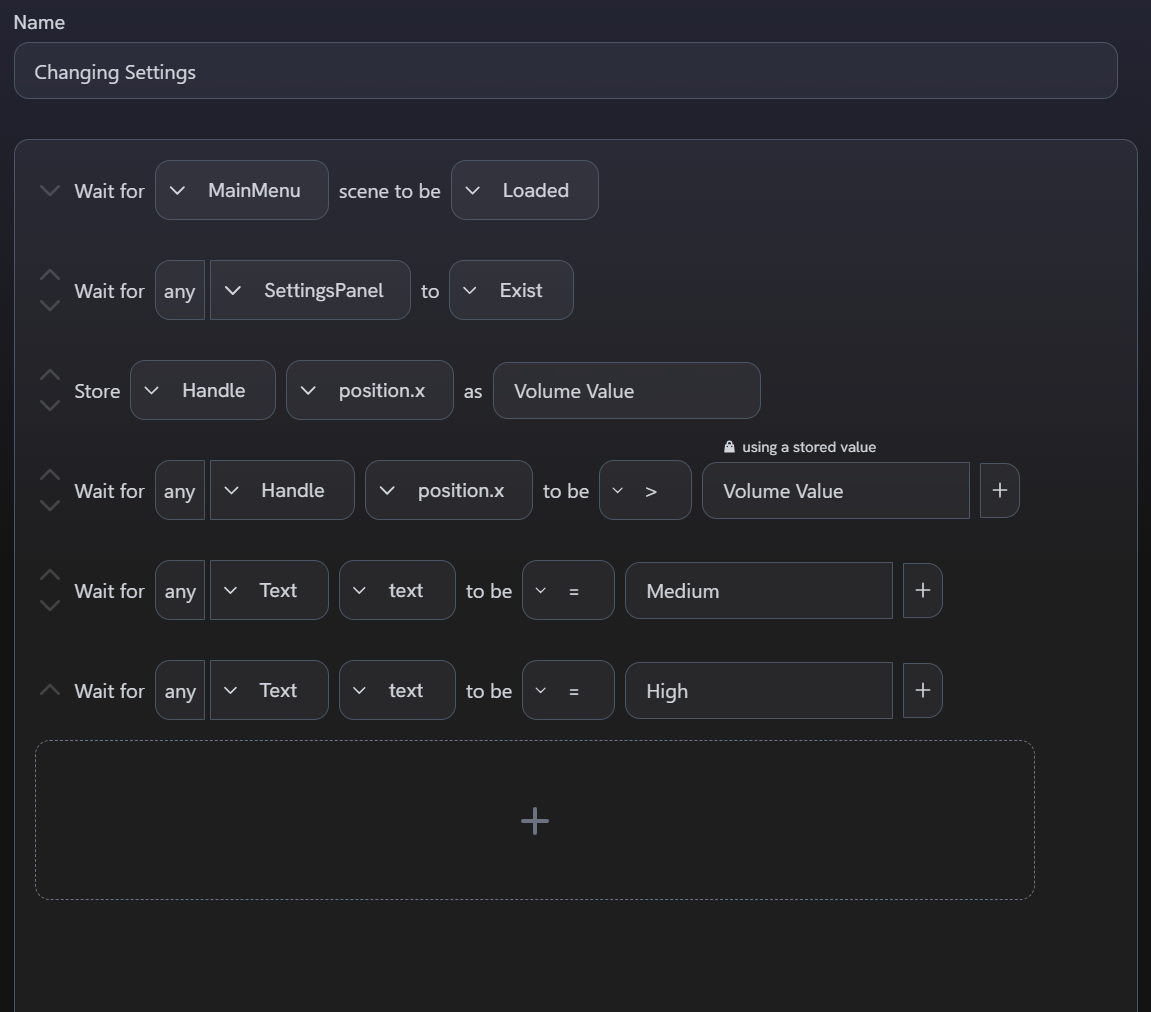
Selecting a Character and Starting a Match
This next example will validate user inputs in addition to interactions with UI components.
For this Gameplay Session: we create a profile by clicking the "Change Profile" button and submitting the name "RG". This will allow us to create a lobby and select a character class through the "Start with Direct IP" menu option. We preview the Male Tank character class before locking in the Female Archer - this allows our Scenario to show examples of UI components changing over time to reflect the highlighted class. We end the recording once the dungeon map loads with our character.
In the Scenario Builder: we'll validate that the profile name is entered correctly, that UI components behave as expected as we click through each menu, that class-specific elements are represented correctly in the state, and finally that locking in a character class gets us to the core gameplay.
If you adjusted the recording interval for the previous Scenario, then set the interval back to 0 now.
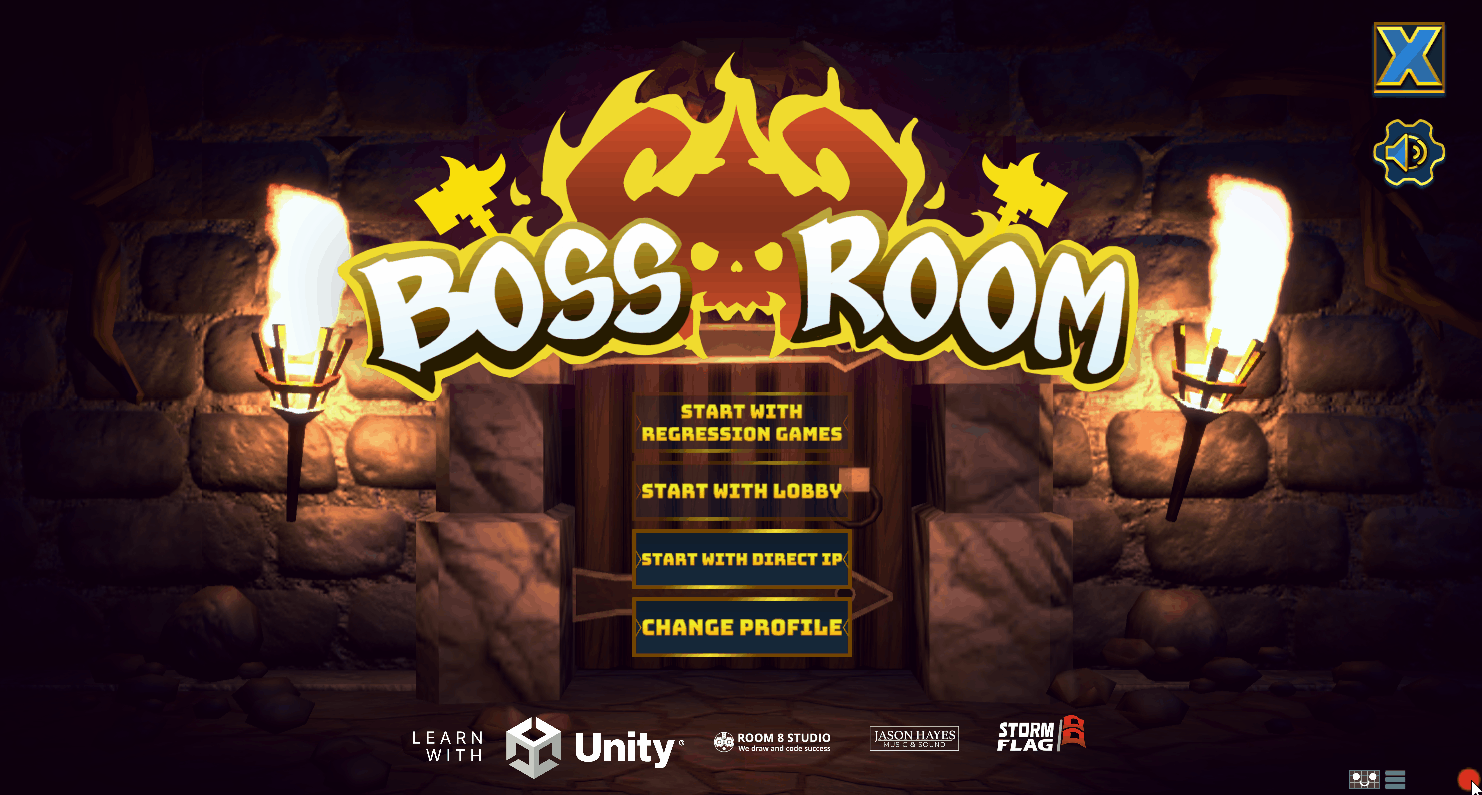
Like in the previous Scenario, we'll start by making sure we're at the Main Menu.
Wait for the left mouse button to be pressed to indicate that we've clicked the "Change Profile" button.
Then, confirm that the ProfilePopup entity is visible.
You'll see that we insert a step to make sure the "Change Profile" button is interactable before waiting for the mouse click.
This isn't required for the Scenario to work, but sanity checks like this will help you diagnose
the root cause of failed Scenarios.
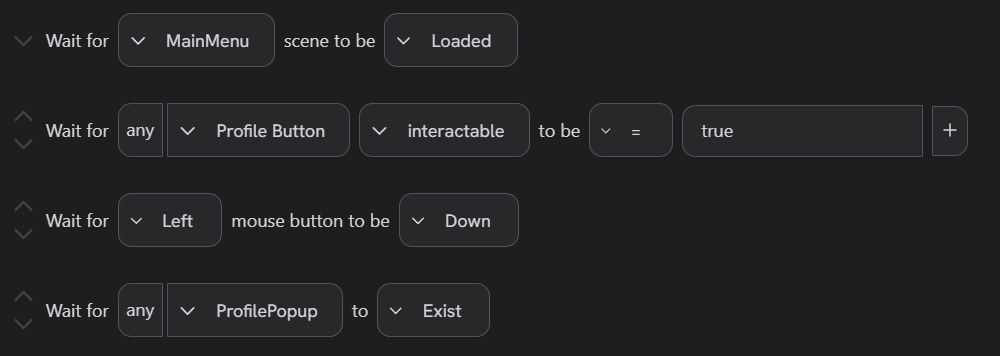
With the ProfilePopup open, we'll validate that the text field reflects the profile name we want to type into it.
We'll need two steps to validate the keyboard input that produces the text "RG".
The first step waits for the shift key and the r key to be pressed together to produce a capitalized "R",
and the second step waits for shift + g for "G".
Then, we can validate that the ProfilePopup's InputText component contains the text "RG".
Why can't we wait for shift + r + g in one "Wait for Key" step?
This type of step validates that every key in the list is simultaneously held or not held.
When users type, they tap keys, releasing one key before tapping the next.
This input pattern differs from triggering gameplay mechanics like spells and abilities using key combinations.
For example, if you type "hello" into a chat-box then you'd expect to release "h" before pressing "e", and so on.
But you may need to hold an obscure combination of keys like ctrl + shift + 1 at the same time
to cast a spell from the 20th hot-bar in your favorite MMO.
When you use the "Wait for Key" step, consider what the player's intentions are when they produce those keyboard inputs.


Creating a new profile in Boss Room will automatically close the ProfilePopup dialog and activate that profile.
Validate that the popup is dismissed, and then wait for another mouse event which indicates
we've selected the "Host with Direct IP" option from the main menu.
This will launch a new dialog, IPPopup.
The next left-mouse event we wait for indicates we've clicked the "Host" button in this dialog,
which brings us to character selection, where we can inspect the available character classes and select one to play as.
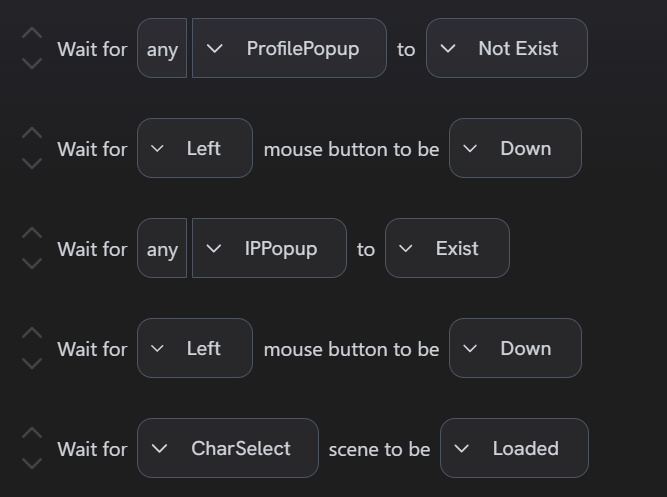

Wait for the Session to click the Male Tank character, then validate that the UI updates accordingly. Boss Room displays a panel in the top-right corner of this scene with information about the selected class, including its name and a preview of its available abilities.
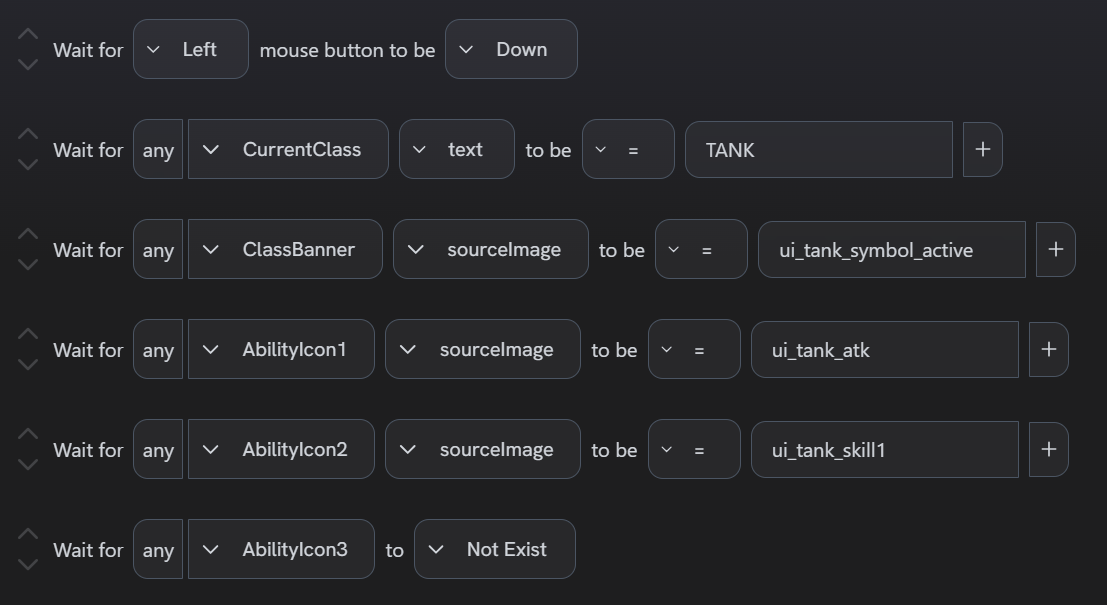
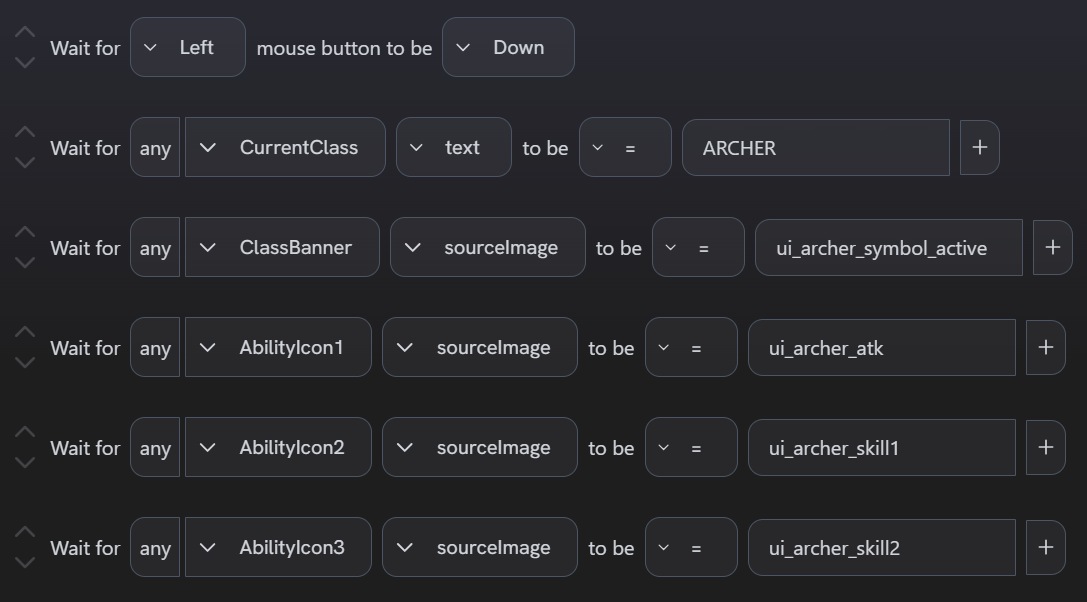
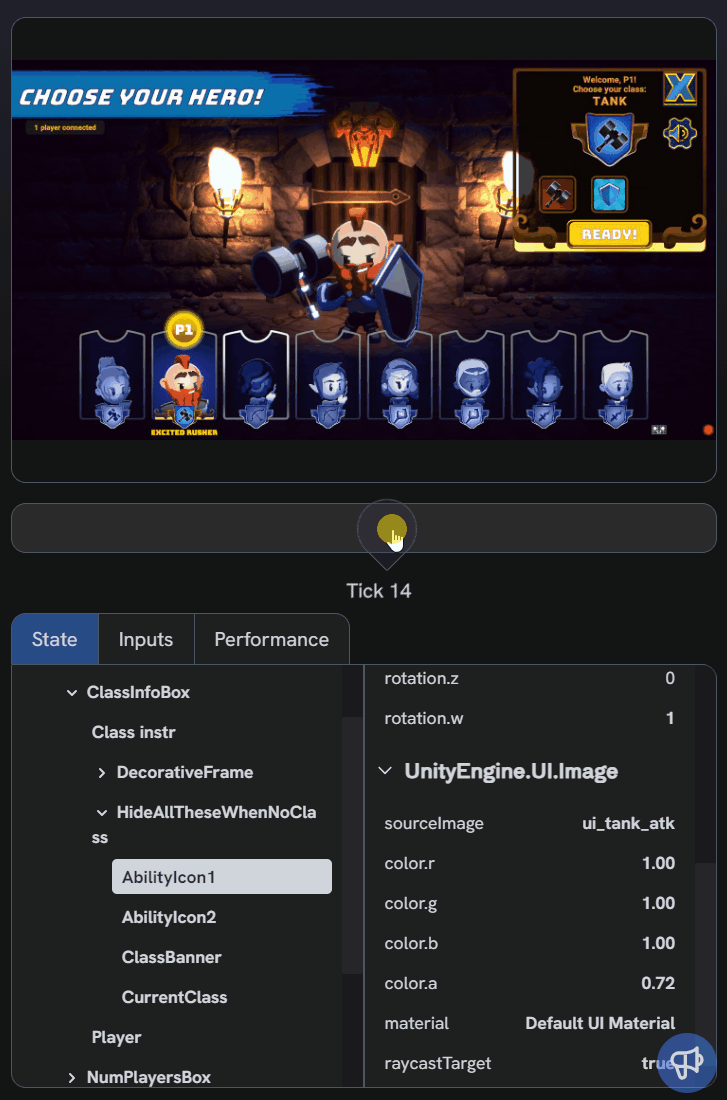
The last piece left in our Scenario is locking in the Archer class and entering the dungeon.
Wait for one last mouse event to indicate we've pressed the "Ready" button.
We can validate that the game registers our selection by asserting the LobbyEndingSplash entity appears in the scene.
Finally, we wait for the BossRoom (main dungeon) scene to load, and validate that our character object is instantiated.
In this case, we check for the PlayerGraphics_Archer_Girl entity to explicitly validate that the correct class is loaded
based on our character selection from the previous steps.
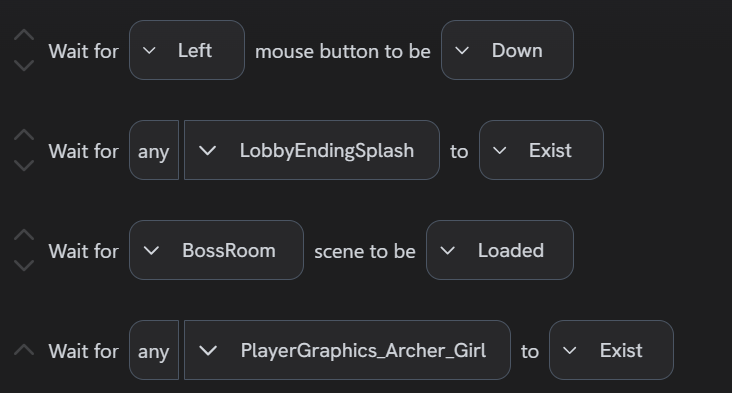
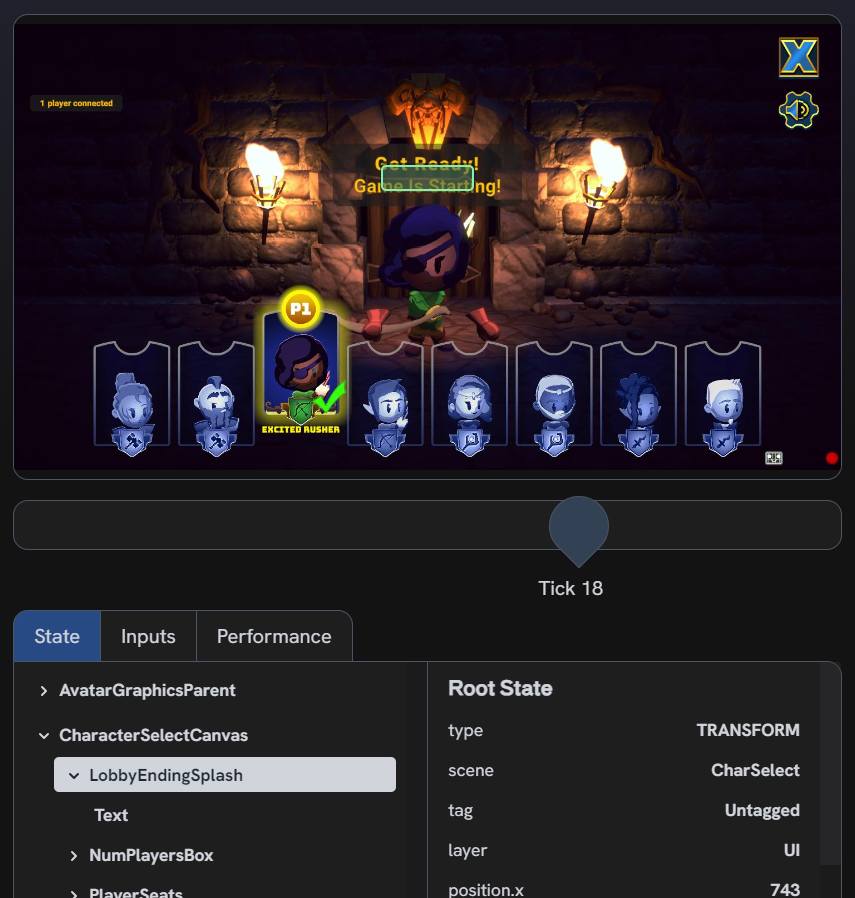
Final Scenario
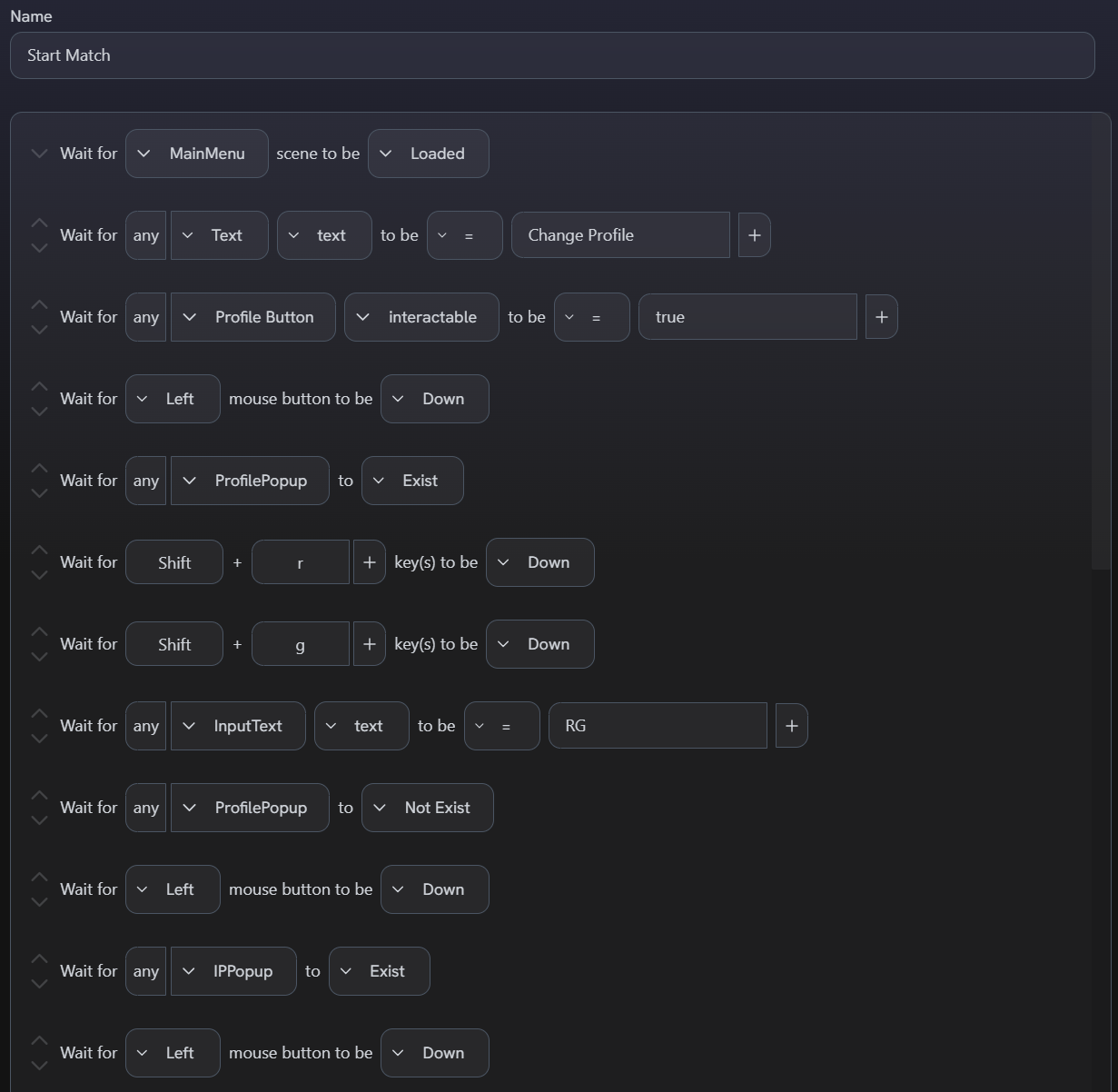
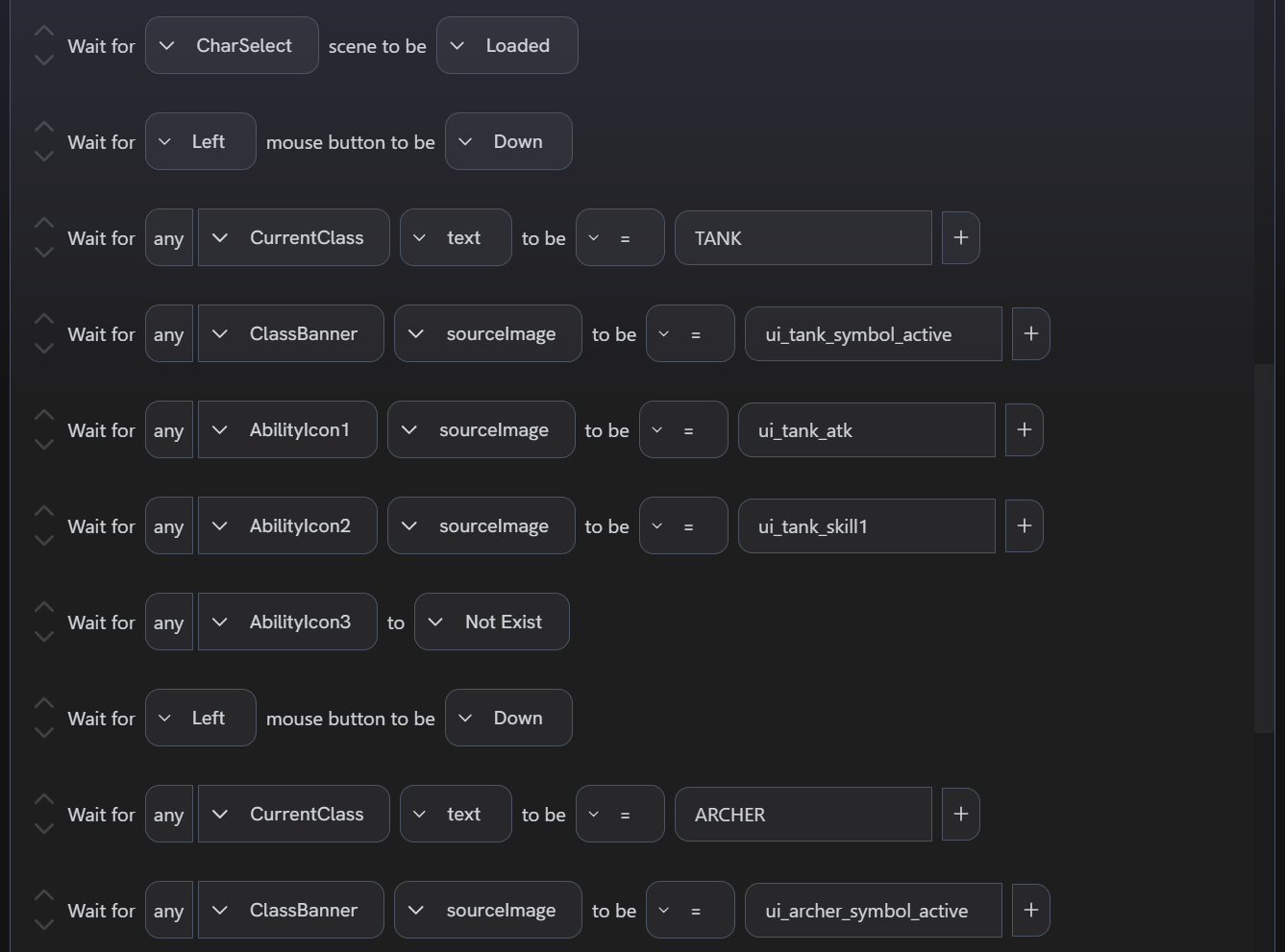

Using Character Skills
Now that we've seen some examples of UI validation, let's address gameplay mechanics.
For this Gameplay Session: we start in the dungeon as a Female Archer character.
First, we target a small pot and press the 1 key to smash it using her basic attack.
Then, we target a heavy pot.
This should replace her first skill with "Pick Up".
We press 1 again to hold the pot in her hands, then make her walk to the opposite end of the corridor before setting the pot down again.
Once the character's hands are free, we make her walk into a group of three Imp enemies and attack all of them at once using her AOE skill.
Pressing the 3 key allows her to target a position on the ground; clicking the right mouse button locks in that position and unleashes a rain of arrows.
These Imps should require three volleys to make them disappear in a puff of smoke.
We end the recording once they've been defeated.
In the Scenario Builder: we'll validate that destroying pots causes them to break into fragments, that contextual abilities change depending on whether the target is environmental or an NPC, and that enemies in an area can be damaged with AOE effects and die as a result of combat.
The Scenario starts simply enough. Validate that the "BossRoom" dungeon scene is loaded and that our Archer character exists. Also assert that there are exactly five breakable pots in the game state (some of these are off-camera).

Whenever we target a valid object by clicking on it with the mouse, a red circle appears around it.
Validate that we've targeted a breakable pot by waiting for a left-mouse event and then validating that the circle
shows around one of the breakable pots in the scene.
Then, validate that a basic arrow attack is launched when the 1 key is pressed.
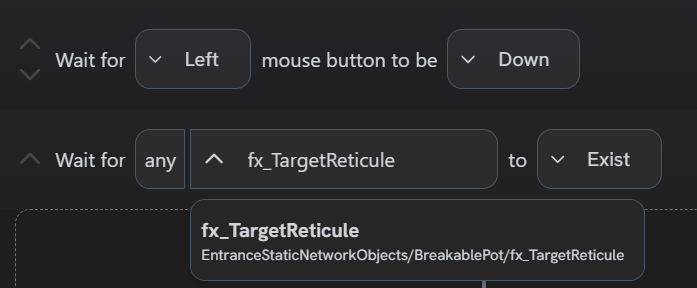

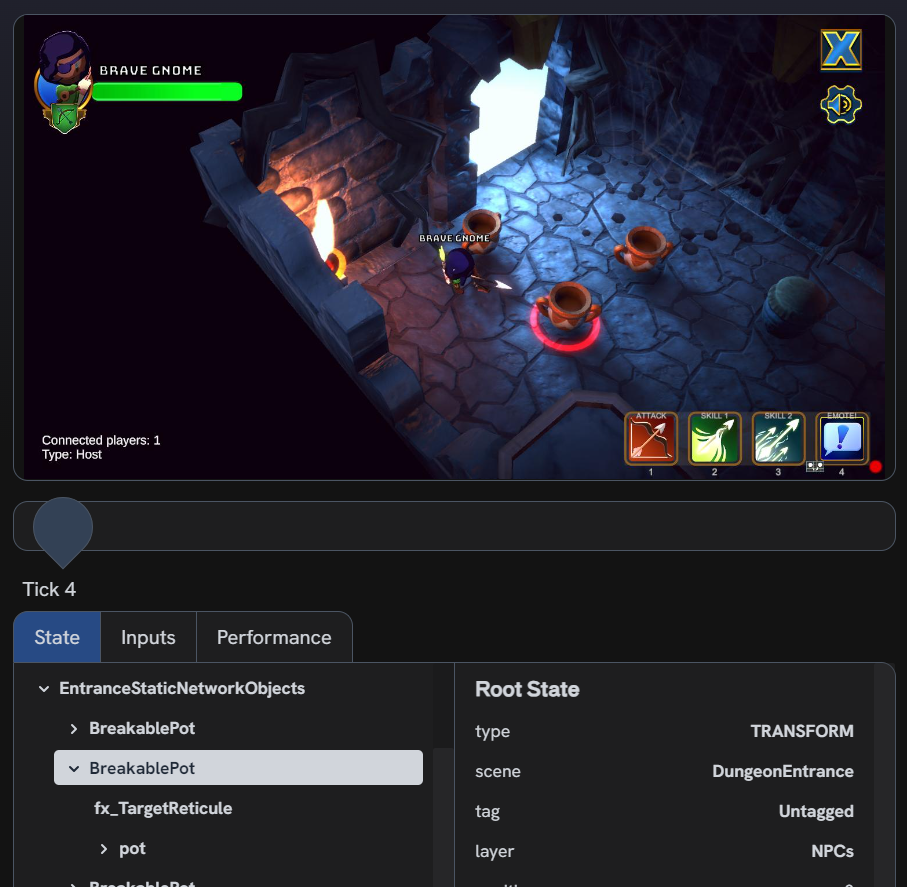
Detecting damaged objects will vary based on your game's implementation.
In Boss Room, the parent BreakablePot object remains in the scene, but its default pot child is replaced with an
env_pot_break_parent which contains a series of broken pieces that fall to the floor in a random arrangement.
We can validate that the pot shattered by asserting this new child object exists, and that it contains some broken pieces.
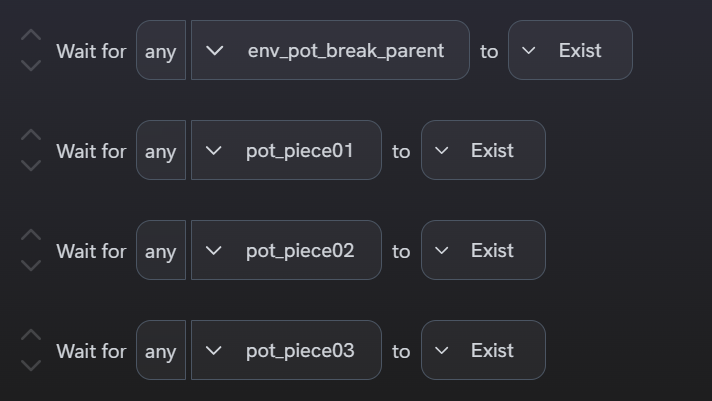
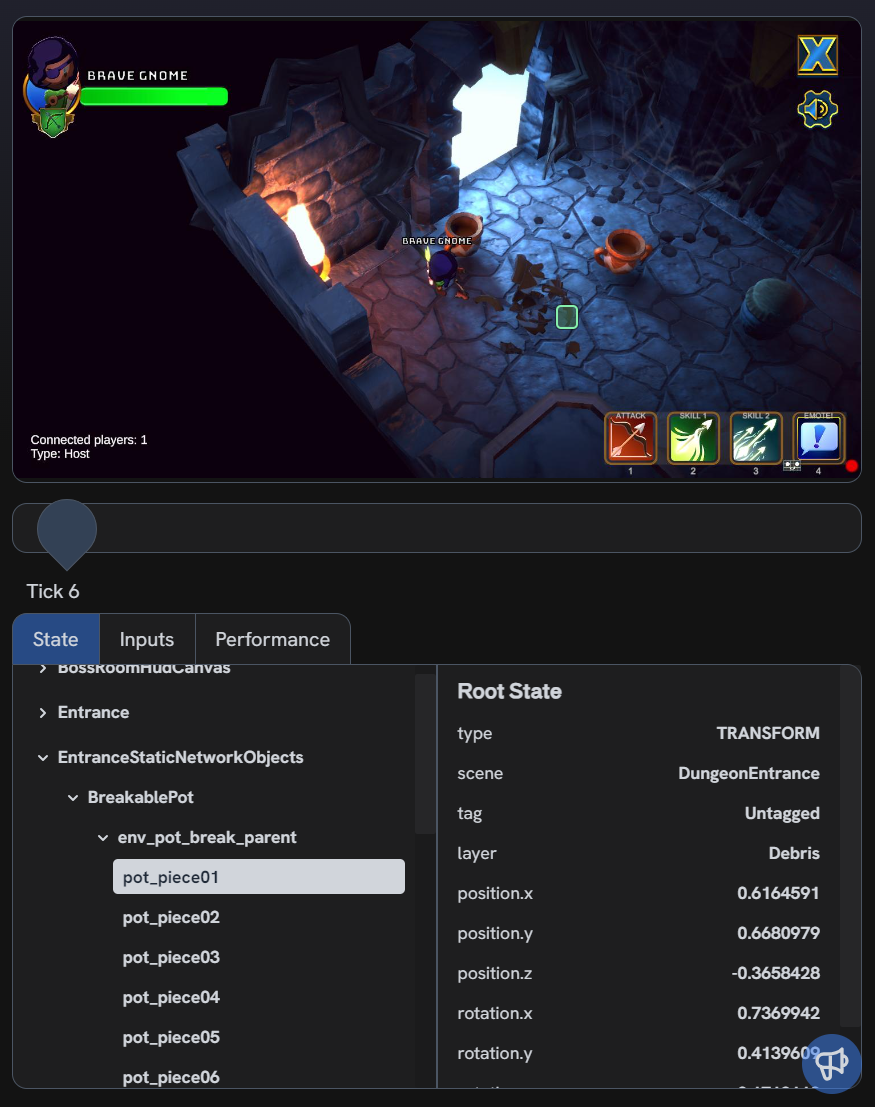
Now let's validate that heavy pots can be picked up and carried by the player character. The next left-mouse event should select the heavy pot. Assert that the character's first skill is replaced with a contextual "Pick Up" action.

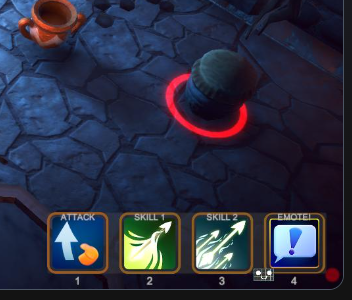
Clicking on the pot to target it won't cause our character to approach it yet. This means that now is a good time to store two values which can help us validate that the character will walk towards the pot, and that the pot will be picked up once we activate the "Pick Up" skill.
Store the value of PlayerAvatar0's position.x as "Last Player Position" and the value of PickUpPot's position.y as "Initial Pot Position".
Then, wait for the "Pick Up" action to be activated with the 1 key.
Validate that the character walks to the pot by waiting for her position.x to be greater than the value we just stored.
Validate that the character lifts the heavy pot by waiting for the pot's position.y to be greater than its
initial resting position on the floor.
As soon as our character picks up the pot, her first ability should be replaced with a contextual "Put Down" action.
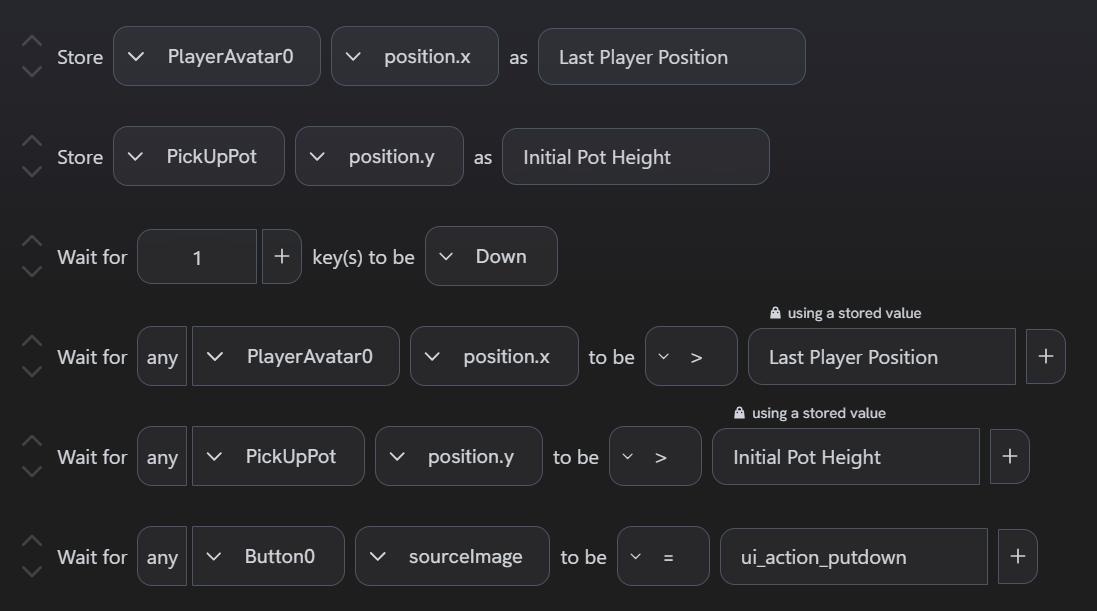
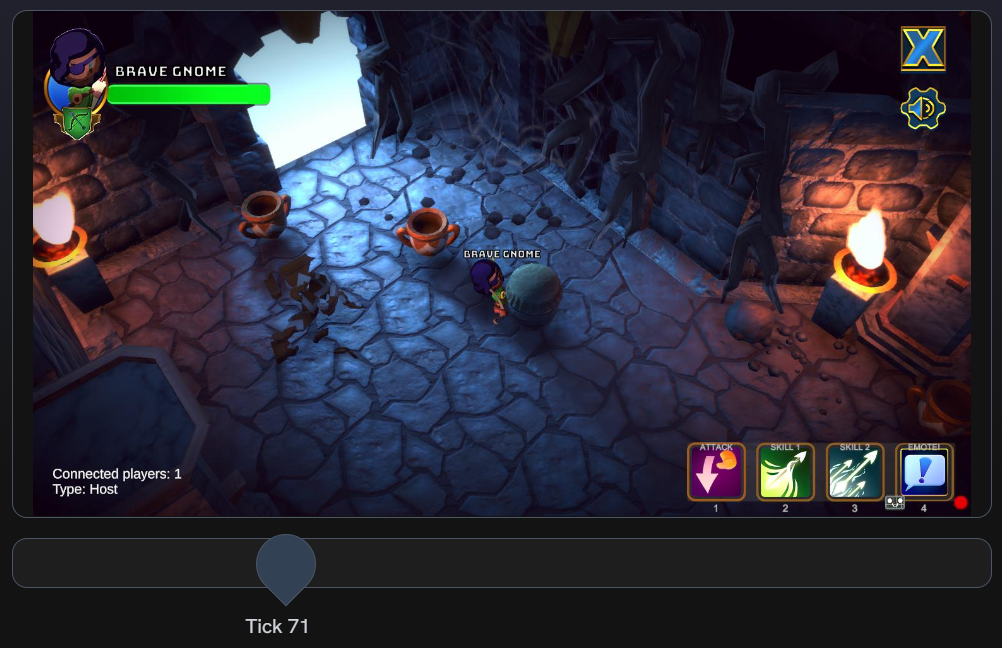
Before we put the pot down, store the character's new position in the "Last Player Position" variable.
This will override the old "Last Player Position" value.
Then, wait for a left-mouse event to move the character.
Clicking on the dungeon floor causes a bullseye to ripple out from the click position, and the character will walk to its center.
Wait for the Click_Feedback bullseye to appear on the ground.
Finally, validate that the character has moved towards this position by waiting for her position.x to be less than the value we just stored.
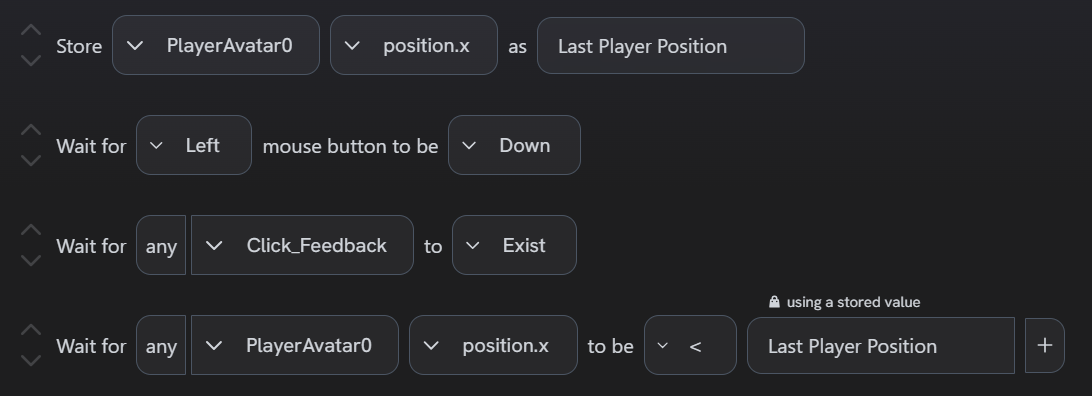
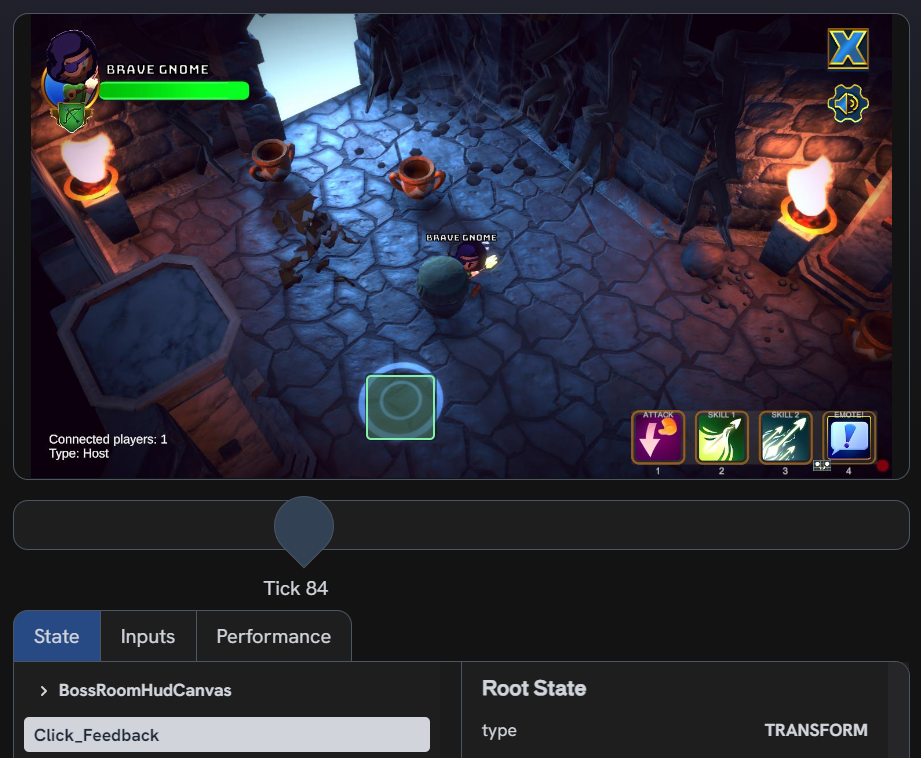
Wait for the "Put Down" action to be activated with the 1 key, and validate that the heavy pot returns
to its initial position.y value to rest on the floor.
As soon as the character puts the pot down, her first ability should revert back to her basic attack.

Let's wrap up this Scenario by validating combat skills. It would be hard to fight Imps if there were no Imps in the scene, so validate that at least one is present.
Why can't I validate that at least three Imps exist in the scene, since this is the number we attacked in the Gameplay Session?
The count option for steps such as "Wait for Existence" and "Wait for State" must be an exact match.
If there are more or fewer entities that satisfy the step than what your count dictates, then the step will fail.
This can be useful for behaviours with some level of determinism.
For example, we know there will always be five pots at the entrance of the dungeon,
so the beginning of this Scenario is able to assert that exactly five exist.
However, Boss Room's enemies are much more dynamic.
The game loads portions of the dungeon as the player gets within a certain distance of unloaded areas,
and spawners throughout the dungeon spawn new Imps over time.
This means that the count for steps that evaluate Imp entities won't be predictable from play-through to play-through.
In these cases, it's best to use the default "any" behaviour rather than supply a specific count.
In a real Scenario, we might validate movement for this portion of the Session, but we'll skip it here since we've already gone over a few movement examples. Assume the character has walked further into the dungeon, and is now ready to attack the group of Imps.
The Archer's AOE skill has multiple behaviours to validate.
First, wait for the 3 key to be pressed and validate that a ClientAoeInput targeting circle appears.
This will follow the player's mouse until they click their right-mouse button to activate the skill at the targeted position.
Wait for a right-mouse event and validate that the ClientAoeInput disappears, and that the appropriate skill animation plays.
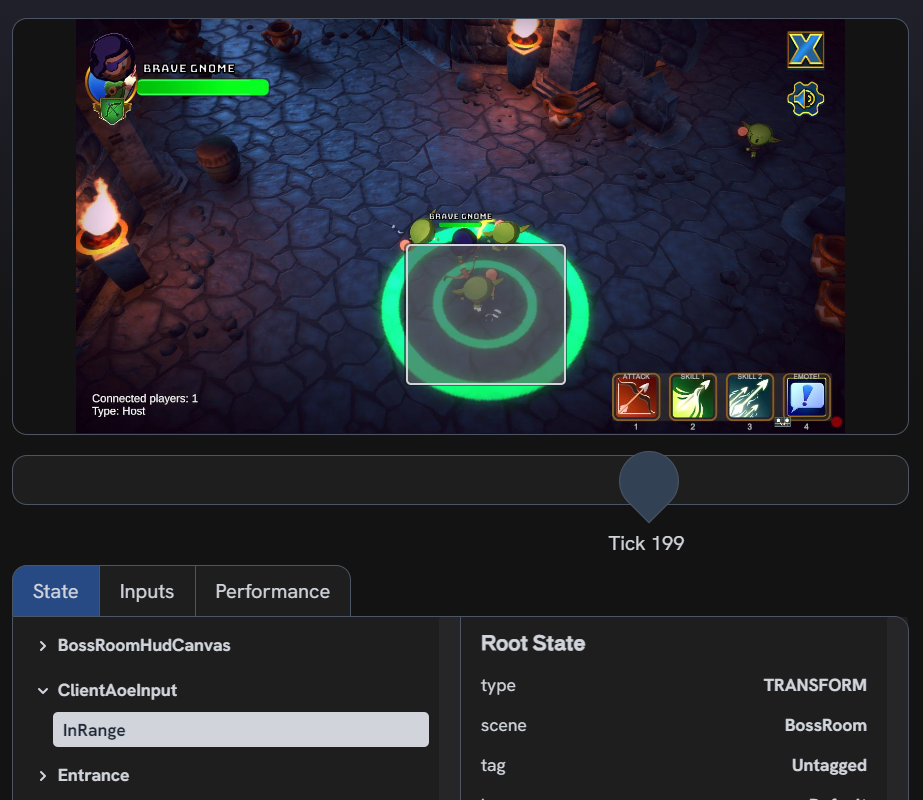
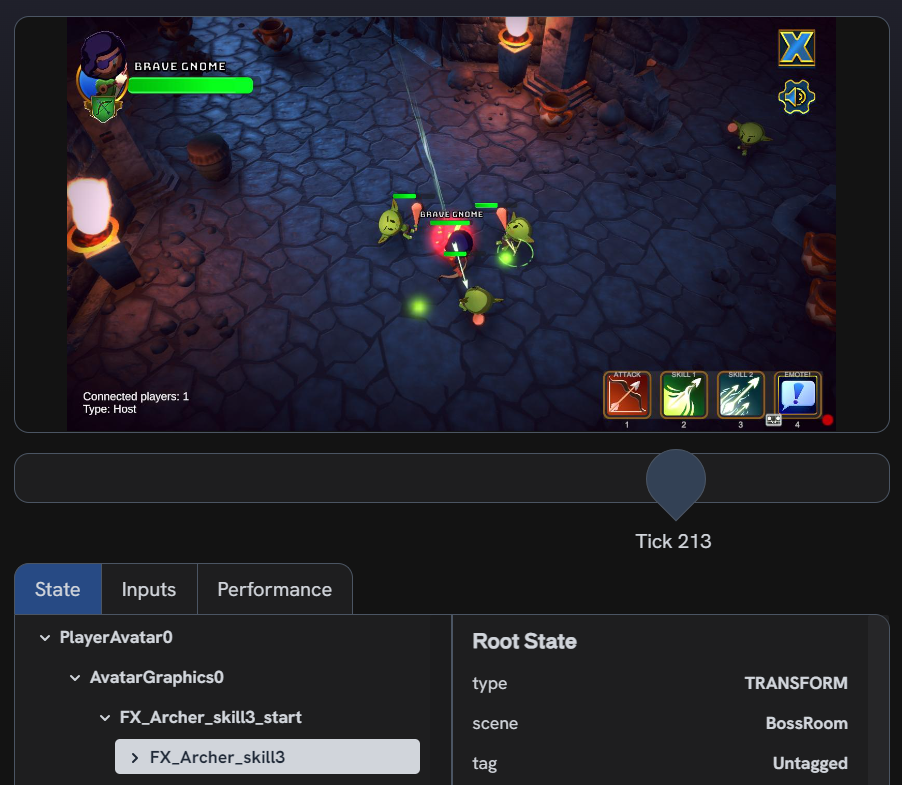

Enemies play stagger animations when they're hit in Boss Room.
We can validate that all three Imps were hit by the AOE skill by asserting that three Hitreact Minor objects appear in the scene.
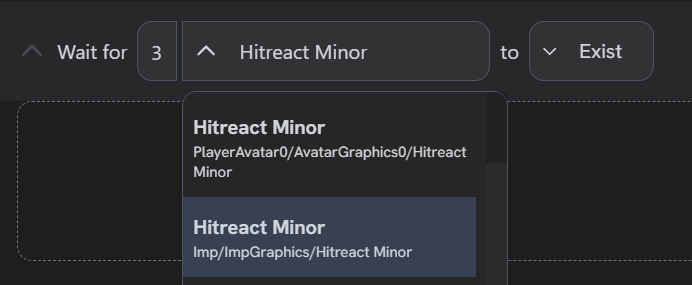
Hitreact animation specifically! The player has one too.Why are we indirectly validating that Imps were hit by looking for stagger effects rather than watching raw health values?
In this Gameplay Session, we cast the AOE skill three times. This means we probably want to validate that every skill cast causes some amount of damage to each Imp. We could try to capture the initial health value of an Imp using the "Store" step, but this will only work before any Imps have taken damage. The "Store" step only succeeds when it can definitively determine what value to capture from a field. If there is only one Imp in the scene, or if every Imp has the same amount of health, then the "Store" step knows what value it should store. However, if we have multiple Imps with various amounts of health remaining, then the "Store" step won't be able to determine which of those values should be stored. This will cause the step to fail.
Alternatively, we could use the "Wait for State" step to assert that three Imps drop below a specific health value (100, 75, 25, etc.). This may work for your game if you know the max health value for an enemy and the minimum amount of damage a skill should deal to that enemy. However, Boss Room doesn't expose this data directly to our SDK. Health bars are rectangles whose fill levels are determined by remaining percentage of health, but the fill level doesn't translate well to a meaningful health value.
There may be many different ways to achieve a Scenario for your game. The "best" configuration of steps will depend heavily on your game state.
For the sake of this example, we'll only write steps for the first AOE effect. However, it would be good practice for this Scenario to repeat the same steps for each instance of the skill to validate that it produces consistent results. You can achieve this by repeating the previous sequence of steps two more times.
Finally, wrap up the Scenario by validating that all three Imps die at the same time and produce an FX_ImpDefeat animation.
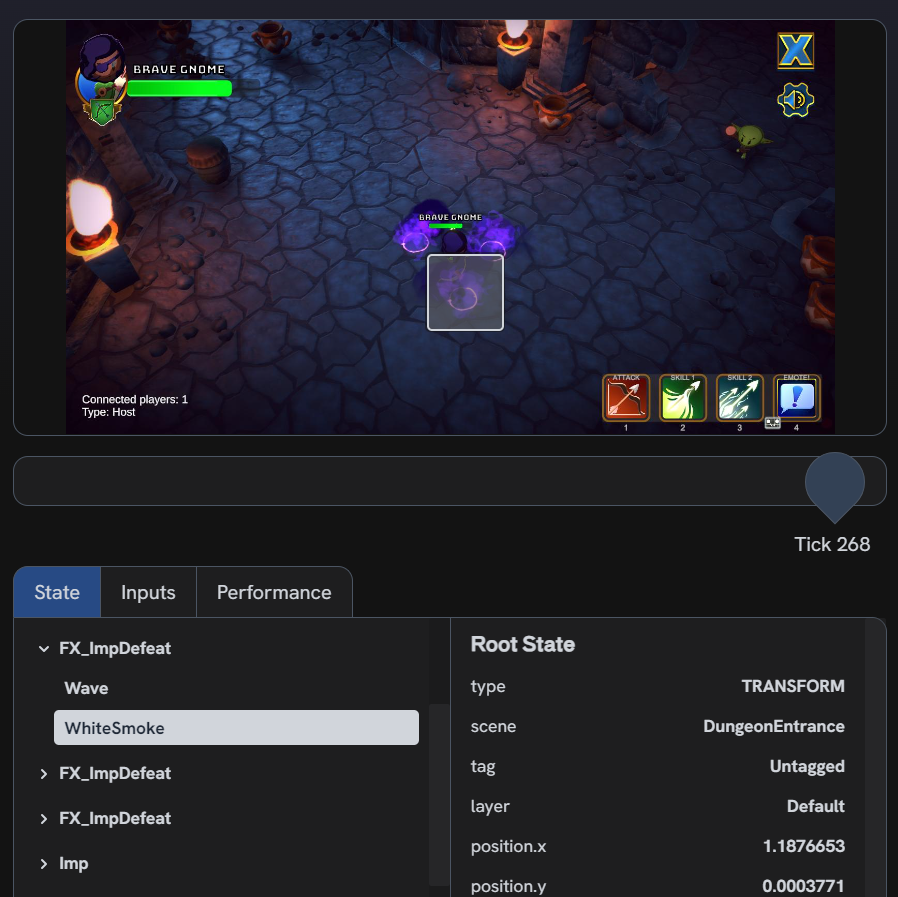
Final Scenario

